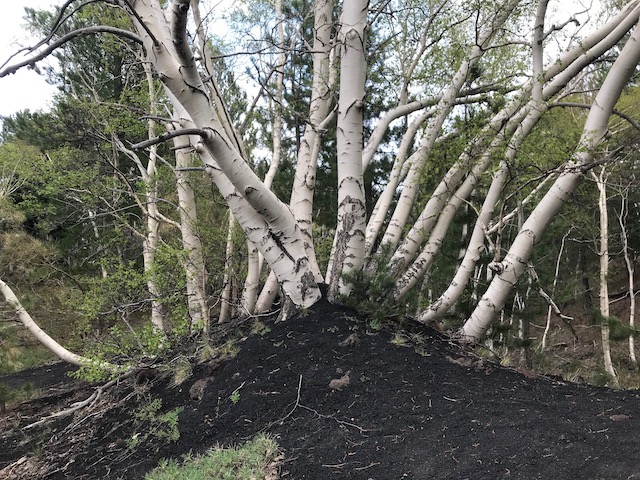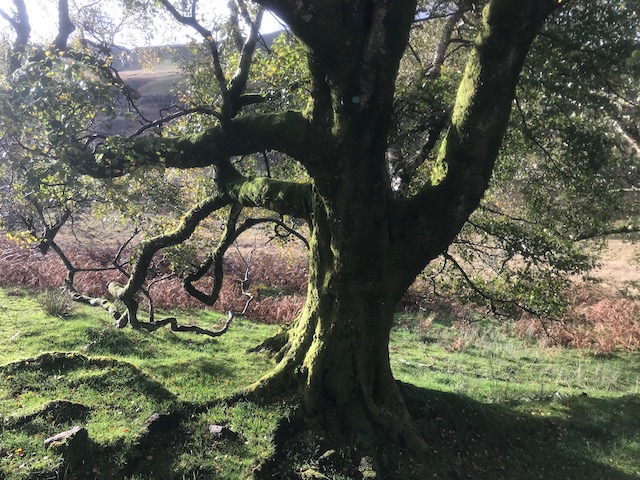The goal of regenerative design is for human and living systems to survive, thrive and co-evolve. Understanding what this looks like is challenging when so much of how industry currently operates does the opposite. In this post we explore the best guide we have to thriving – the living world itself. We call this the Living Systems Blueprint.
Why it’s so hard to see the future
A viable world in which humans and the rest of the living world survive, thrive and co-evolve doesn’t exist yet. It is something we aim to create when we talk about regenerative design. But while it is one thing to write these aims down, it is another to be able to clearly imagine it.
The Three Horizons Model shows us that the destructive patterns of the present are so dominant that they obscure our view of the future. But if the role of the regenerative designer is to create a transition to this viable future, then we need some sort of guide to ensure we are heading in the right direction. The best guide we have is living systems themselves.
Three characteristics of thriving, living systems
In the Regenerative Structural Engineer, we identified three particular characteristics of thriving, living systems. Together these offer us insight into thinking about how, as designers, we can contribute to, rather than undermine and destroy, system thriving. These three characteristics are interconnection, symbiosis and self-organisation. Together we call these three factors the Living Systems Blueprint.
Interconnection

Beech trees in a woodland communicate with each other through using the mycelium network that links their roots. Through this network they can share nutrients and send distress signals. For so long, science approached living organisms as solo entities. But a growing body of research, like that which showed communication of trees through the mycelium in the soil, is shifting our perception. Now, where we are starting to look for it, we are finding this level of interconnection, sharing and communication in the living world goes far and wide. It’s like we have discovered that they were talking to us behind our back.
What does this level of interconnection provide? As Donella Meadows describes in ‘Thinking in Systems‘, it creates feedback loops, which in turn create resilience. When one part of system receives a signal that another part is in distress, it can divert resources or change behaviour in order to reduce that stress. This is resilience, the ability to respond to shock. The high degree of interconnection in living systems gives rise to a complex web of feedback loops that keep living systems in balance.
Interconnection is the first characteristic in the Living Systems Blueprint. When we try to imagine a world in which humans and living systems are surviving, thriving and co-evolving, think about interconnection. How do grow the levels of interconnection between humans and the rest of the living world so that we can live in balance?
Symbiosis

All life is derived from the energy of the sun and the minerals of the earth. From these abundant resources, living systems create all the richness and complexity we see in places that thrive. There is no waste in the living world. The outputs of one process become the inputs to another. But this isn’t a zero-sum game, over time the web of life becomes richer. We call this positive symbiosis.
We can see process at play when an area of woodland is burnt down by fire or flattened by a storm. The first trees to return are the pioneer species. Their roots stabilise the soil. They grow quickly, but their thin canopy lets lots of light through, creating shelter for slow-growing species to develop. And their leaf fall enriches the soil, feeding the next generation of trees. Over time, these pioneer species are replaced by larger growing trees, that create the overstorey for the wood, and shrubs and middle-height trees that create the middle tiers of the canopy. This is a richness that grows in balance with the resources that feed it because of the high levels of interconnection in the system.
Symbiosis is the second characteristic in the Living Systems Blueprint, and it builds on the first characteristic, interconnection. Humans have lived for millennia as part of this balanced system, our harvest playing an active part in keeping the living world in balance (see for example coppicing). When we try to imagine a world in which humans and living systems are surviving, thriving and co-evolving, think about how we can reintegrate ourselves into positive cycle of symbiosis. Ones in which we can meet our needs while creating a positive impact on the living system in that place.
Self-organisation
The third characteristic of thriving living systems that we look at is their ability to adapt or self-organise. Evolution is often thought of as survival of the fittest, but a more holistic interpretation is to say that the patterns of living that evolve are those that are the best fit to the local ecosystem. This process of self-organisation is guided by the high-levels of interconnection, and powered by the enriching effect of positive symbiosis.
Experiments in re-wilding show what happens we leave living systems to self-organise. An exquisite balance of species emerges that is the best fit with the local environmental conditions.
This third characteristic in the Living Systems Blueprint invites us to imagine a world in which humans can exist as part of that self-organising system balance, not controlling the ecosystem, but working as part of it to find the best balance for all species. I see this is as the biggest challenge to imagining a regenerative future because we have travelled so far from a time at which we did live in balance with the rest of the living world.
The Living System Blueprint invites to engage with that challenge. Not by thinking how do we go back to some pre-technological way of living. But how do we evolve to re-integrate our ways of living, working, designing and building with this wider living world.
Using the Living System Blueprint
The Living Systems Blueprint is a guide to a regenerative future. Use it to support to guide the three facets to the work of the regenerative designer:
- Imagining the future – what does an interconnected, symbiotic, self-organising world look like?
- Building the transition – how do we start to foster interconnection, symbiosis and self-organisation?
- Managing out the present – how we do we dismantle that which disconnects, that which depletes and that which prevents our co-evolution?
References and further reading
The Hidden Life of Trees, Peter Wohlleben – Much of my thinking about how living systems work has been inspired by this book. Wohlleben, P., 2017. The Hidden Life of Trees. Williams Collins Books.
Thinking in Systems, Donella Meadows – I draw lots of my thinking about how living systems work by applying Meadows’s ideas about well functioning systems to living systems. Meadows, D., 2008. Thinking in Systems. Chelsea Green Publishing.


One Reply to “The Living Systems Blueprint”
Comments are closed.